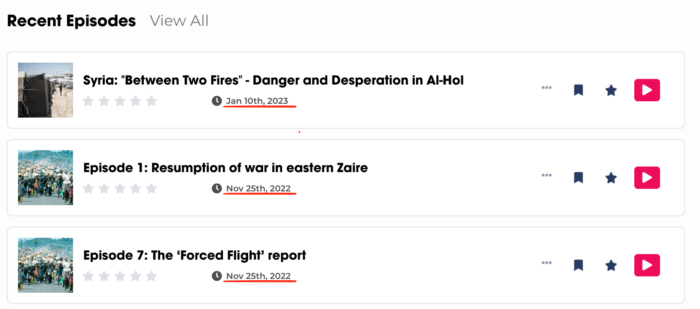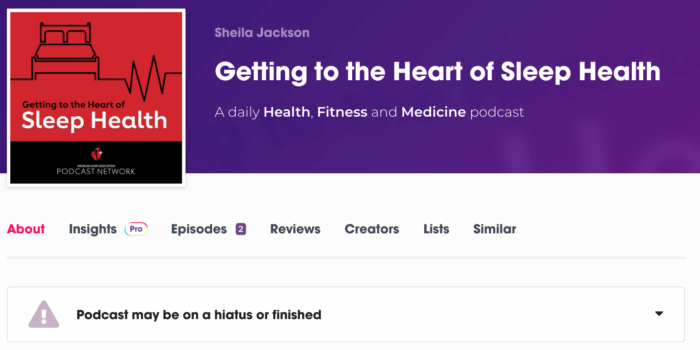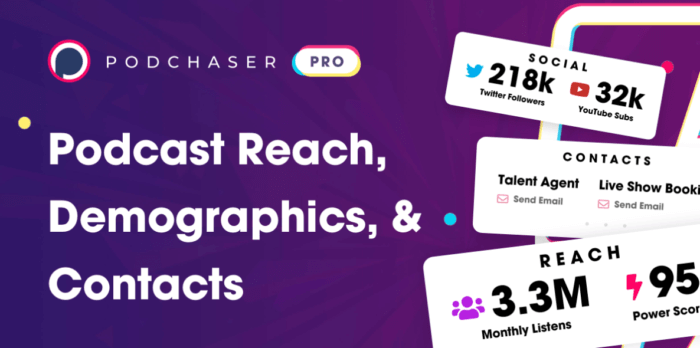6 Do’s and Don’ts: Starting a Podcast as a Nonprofit
While the benefits of starting a podcast are plentiful, podcasting is resource intensive and usually takes dozens of episodes before you begin to see tangible results. Before recording your first episode, you need research from other nonprofit podcasts, and learn from their successes and failures.
In this article we share 3 “do’s” and 3 “don’ts” of nonprofit podcasting (with real world examples) so you can bring new insights into the creation of your show.
Table of Contents:
- The 3 Do’s With Your Nonprofit’s Podcast
- 3 Don’ts With Your Nonprofit’s Podcast
- Wrapping Up – Starting Your Nonprofit’s Podcast and Utilizing Podchaser Pro
3 Do’s With Your Nonprofit’s Podcast
1) Do: Release Episodes Consistently

Podcast audiences have an unbelievable amount of content available to them at all times, so maintaining their consistent attention and engagement is very difficult. At a bare minimum, you need to release your podcast episodes on a regular schedule to keep your podcast on the top of your audience’s mind.
We recommend a weekly release schedule because it strikes the balance of consistency without creating an overwhelming amount of weekly work for your organization. And for the listeners, a weekly schedule provides an opportunity for your podcast to become part of their routine.
If you’re curious what day of the week is best to release your podcast episode, check out our data report about the best day to publish your podcast.
Example:
The Doctors Without Borders podcast, Everyday Emergency, posted 7 episodes in November 2022 and then remained radio silent until releasing an episode in January 2023. This inconsistent schedule makes it difficult for listeners to keep up with the podcast.
2) Do: Repurpose Content

Repurposing your content allows you maximize the benefits of your podcast content. The idea is to cut your podcast content up into bite size pieces to be shared as many places as possible.
The most common type of content repurposing is on social media with video podcast clips, audiograms, and infographics. But there’s even more ways to repurpose your content beyond social media, like blog posts, newsletters, and transcripts. If you want to learn more, check out our article, 7 Ways to Repurpose Your Podcast Content.
Example:
The Center for International Private Enterprise produces the podcast Democracy that Delivers, a show about the intersection between democratic and economic development. As part of their content repurposing, they released a 1 minute video clip of an episode on Facebook. This gives the opportunity for that clip to spread via Facebook’s algorithm and introduce new listeners to their show, as well as reminding their current listeners to download the latest episode.
3) Do: Highlight Your Organization’s Work
The two main reasons nonprofits start podcasts are to raise awareness and raise funds. In order to accomplish both of these goals, your podcast should focus on highlighting the amazing work your organization is doing. When a listener hears about your work through your podcast, you are building trust and reputation as a cause worth supporting. Eventually, some of your listeners will either share your work with their friends and/or donate their time or money.
Example:
Stories from Skid Row is a podcast created by Union Rescue Mission – a Christian organization dedicated to serving those experiencing homelessness in Los Angeles’ Skid Row. Their podcast brings you right to the front lines, where they interview people living on the street. They discuss the person’s history, as well as how Union Rescue Mission is changing their future for the better.
3 Don’ts With Your Nonprofit’s Podcast
1) Do Not: Podfade

Podfade means that your podcast starts out strong, but you slow down and eventually stop making episodes. There are a few reasons why podfade is so prevalent.
1) Because the creator runs out of ideas for new episodes
2) The podcast wasn’t gaining popularity, so the creators lost motivation.
The first one can be solved with planning. You really need to make sure that the topic you choose is something you can talk about forever, because if your podcast becomes successful, you’ll eventually record hundreds of episodes. So before recording anything, write down at least 25 episode topics to see how easily you can come up with new ideas.
The second issue is solved through perseverance. Podcasts are not a quick-hit medium. You’re not going to become viral overnight. But what podcasts lack in immediacy, they make up for in longevity. Each episode helps roll the snowball along and slowly grows your show. You know what this is like with your nonprofit too – the first donor is much harder to get than the second, and the third is even easier than that. So keep making good content and have trust that your audience will grow overtime.
Example:
Getting to the Heart of Sleep Health was a daily podcast by the American Heart Association that only released two episodes before calling it quits. They never gave themselves a chance to succeed by throwing in the towel that early! Another potential lesson from this podcast: it’s likely that they started releasing episodes and found that a daily podcast was too much work – this is partially why we endorse a weekly release schedule.
2) Do Not: Create a Limited Run Series
Some of the biggest podcasts of all-time have been limited-run series, but we still don’t recommend this style of podcast for nonprofits. Here’s why: limited-run podcasts can become viral, but have a difficult time maintaining that relevance after the season has ended. As a nonprofit, you need consistency from your donors and supporters in order to keep your operations going.
So you need to maintain that consistency with your podcast as well. We’ve already discussed why you should be releasing your content consistently, but it’s also important to not fall into the appealing trap of creating a limited-run podcast series.
Example:
St Jude’s Mission of a Lifetime only released 5 episodes, all telling one large story. As listeners, we love these multipart stories, but if you’re going to choose that storytelling format, you need to break it up into seasons, so listeners know that they can always come back for more.
3) Do Not: Brand Your Podcast too Heavily

Listeners come to podcasts to learn and to be entertained – not to be advertised to. Research has shown that podcast listeners are receptive to advertisements, but only when handled correctly. Audiences like when advertisements are authentic and organic to the content, not heavy-handed and in-your-face like traditional TV and radio advertisements.
So if your podcast is too heavily branded in the title, art, and on each episode it runs the risk of turning listeners away before they even listen to your podcast.
Example:
The title of this podcast is, “Stories of the Relentless: A Binge Worthy Series by the American Heart Association”. With a title like that, the podcast already feels like an advertisement. At first glance, listeners are already skeptical – which is the last thing you want with your nonprofit’s podcast.
Wrapping Up – Starting Your Nonprofit’s Podcast and Utilizing Podchaser Pro

If you’ve read all of this and you’re ready for the next step – congrats! We’ve written many more articles that will help you get started on your podcasting journey:
- The Ultimate Guide to Branded Podcasts
- How to Start a Podcast with No Audience
- The Best Beginner Podcast Set-up
- And more!
And starting your own show is only one way for your organization to utilize podcasts. The other most common methods are guesting on other podcasts and buying podcast advertisements. We built Podchaser Pro, the world’s most comprehensive podcast database, to help nonprofits quickly achieve all of their podcasting goals.
Read our article, “3 Ways Nonprofits Use Podchaser Pro” to see why Forbes called Podchaser Pro, “an incredibly useful tool for podcast marketing or booking guests or promoting to media or for research and development.”
Unlock more with Podchaser Pro
- Audience Insights
- Contact Information
- Demographics
- Charts
- Sponsor History
- and More!

- Account
- Register
- Log In
- Find Friends
- Resources
- Help Center
- Blog
- API
Podchaser is the ultimate destination for podcast data, search, and discovery. Learn More
- © 2024 Podchaser, Inc.
- Privacy Policy
- Terms of Service
- Contact Us